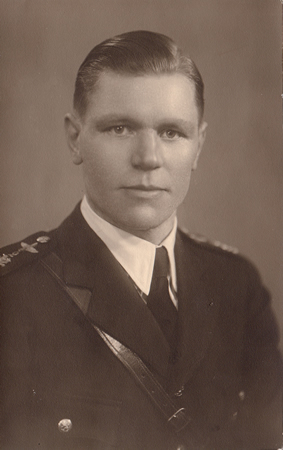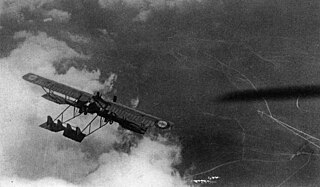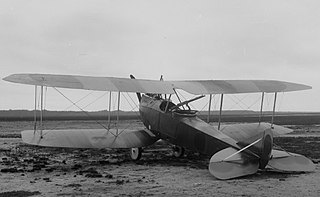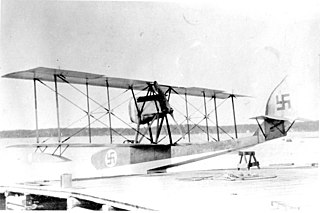AB Thulinverken was a company in Landskrona, Sweden, founded in 1914 as Enoch Thulins Aeroplanfabrik by the airman and aircraft designer Dr. Enoch Thulin. The company became Sweden's first aircraft manufacturer. In 1920, Thulin also started manufacturing automobiles, which continued until 1928. During World War I, the company came into financial difficulties and was reconstructed in 1922 as AB Thulinverken. The manufacturing of brake systems became a main focus of the company. In 1958, Thulinverken merged with Svenska AB Bromsregulator. The remains of Thulinverken are now a part of SAB Wabco AB, which is owned by the French Faiveley Transport company since 2004.

VL Kotka ("Eagle") was a Finnish two-seat, biplane maritime patrol aircraft, designed and built by the Valtion lentokonetehdas or VL. It was meant as a cheaper replacement for the outdated IVL A.22 Hansas that were in service with the Finnish Air Force.

Jorma Kalevi Sarvanto was a Finnish Air Force pilot and the foremost Finnish fighter ace of the Winter War.

Adaridi AD 3 was a wooden aircraft designed by the Russian engineer Boris Adaridin, who lived in Finland. It was a high wing aircraft with a low-powered engine. In 1923, the Finnish Air Force ordered one Adaridi aircraft. The aircraft was not given any official designation code. The maiden flight was on April 17, 1924.

The Caudron C.59 was a French, two-seat biplane with a single engine and a canvas-covered fuselage, produced between 1922 and 1924. Suitable for a variety of roles, more than 1,800 Caudron C.59s were manufactured.

The Caudron C.60 was a French two-seat biplane of the 1920s and 1930s with a single engine and a canvas-covered fuselage. The French aircraft manufacturer Caudron developed this aircraft from the Caudron C.59. It was mainly used as a trainer aircraft.

The Caudron G.3 was a single-engined French sesquiplane built by Caudron, widely used in World War I as a reconnaissance aircraft and trainer.

The Caudron G.4 was a French biplane with twin engines, widely used during World War I as a bomber. It was designed by René and Gaston Caudron as an improvement over their single-engined Caudron G.3. The aircraft employed wing warping for banking. The first G.4 was built in 1915, and it was manufactured in France, England and Italy. It was the world's first twin-engine aircraft to be widely used, starting in March 1915.

The Blériot-SPAD S.34 was a French twin-seat, single-engine biplane flight training aircraft designed in 1920. The side-by-side seating arrangement was unique for its time. 150 aircraft were built, 125 for the French Air Force, who used them until 1936.

The Nieuport 21 was a French single-seat, single-engine fighter aircraft used during World War I. The aircraft was used by the French, Russian, British and American air forces. After the war, the Nieuport 21 was a popular civil aircraft.

The Rumpler 6B was a German single-engine floatplane fighter with a biplane wing structure, designed and built by Rumpler Flugzeugwerke, in Berlin Johannisthal and introduced in 1916.

The Rumpler C.VIII was a German single-engine biplane advanced trainer manufactured by Rumpler Flugzeugwerke, in Berlin Johannisthal in 1917.

The SIAI Savoia S.9 was an Italian reconnaissance flying boat, manufactured by Societa Idrovolanti Alta Italia (S.I.A.I.) from 1918. The wing structure was unusual by being a single-bay biplane wing, with additional struts mounted mid-bay at the junction of the flying and landing wires, so that it appeared to have a two-bay wing. The S.9 was also licence-built in France by CAMS as the CAMS C.9.
No. 26 Squadron, renamed No. 26 Fighter Squadron was a fighter squadron of the Finnish Air Force during World War II. The squadron was part of Flying Regiment 2 during the Winter War and Flying Regiment 3 during the Continuation War.
Flying Regiment 3 was a fighter aircraft regiment of the Finnish Air Force. The regiment took part in the Continuation War and the Lapland War.

Hansa-Brandenburg W.33 was a German two-seat, single-engined low-wing monoplane floatplane, which had been developed by Hansa und Brandenburgische Flugzeugwerke during World War I as a higher powered enlargement of the similar Hansa-Brandenburg W.29 and despite the increase in size the two types are very difficult to differentiate. Although the W.33 was built in small numbers during the war many license built versions were built after World War I.

Gustaf Erik Magnusson was a Finnish major general and Mannerheim Cross Knight. He was the commander of the No. 24 Squadron and Flying Regiment 3 during World War II. He also flew 158 sorties as a fighter pilot and shot down 5 1/2 enemy aircraft.

Nils Edward Katajainen was a Finnish fighter pilot and a Mannerheim Cross Knight. He held the military rank of sergeant. He flew 196 sorties and shot down 35 enemy aircraft.

The Caudron G.2 was a single-engined French biplane built by Caudron, used in World War I as a reconnaissance aircraft and trainer.

Erik Edward Lyly was a Finnish fighter pilot and ace in the Continuation War. He flew in the LeLv 24 and LeLv 34, the most successful fighter squadrons of the Finnish Air Force, often flying as a wingman for the most proficient Finnish ace Air Sergeant Master Ilmari Juutilainen. He achieved a total of 8 air victories during the wars. His highest rank during the war was Sergeant Master.

















